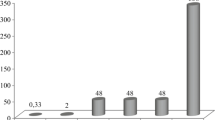Abstract
Results of a study of the structure and transformations of gels due to slow and rapid hydrolysis in an acid aqueous medium without organic solvents are presented. The conditions of formation of clathrates in gel clusters are discussed and results of DTA, IR-, and x-ray phase analyses of gels obtained by slow and rapid hydrolysis with different catalysts are presented. Conditions of carbon clathrate formation in gel clusters are specified
Similar content being viewed by others
References
G. D. Semchenko, “Part I. Preparation of binders for ceramic production by the sol-gel method. 2. Preparation of ethylsilicate binders and their modification,”Ogneup. Tekh. Keram., No. 3, 21–24 (1999).
G. D. Semchenko, “Part I. Preparation of binders for ceramic production by the sol-gel method. 3. Processes of hydrolysis and gelation in ethylsilicate binders without organic solvents,”Ogneup. Tekh. Keram., No. 5, 3–8 (1999).
C. J. Brinker, K. D. Kufer, D. W. Schaefer, and C. S. Ahley, “Sol-gel transition in simple silicates,”J. Non-Cryst. Solids,41(1), 47–64 (1982).
J. C. Powxviel, J. P. Boilot, J. C. Bolocie, and J. G. Lallomand, “NMR study of the sol/gel polymerization,”J. Non-Cryst. Solids,89(3), 345–360 (1987).
V. A. Sviderskii, V. S. Klimenko, and S. V. Klimenko, “Sol-gel process of synthesis of amorphous oxides,” in:Abs. Rep. Int. Sci.-Eng. Conf. “Development of Technical Chemistry in Ukraine,” Issue 1 [in Russian], KPI, Kiev (1995), pp. 10–11.
V. G. Tarasevich, “Inorganic gels with particles of nanometric size,” in:3rd Mater. Res. Symp., Reno, Nev., Apr. 5–9, 1988, J. Am. Ceram. Soc. (Pa.), Pittsburgh (1988), pp. 225–238.
D. R. Ulrich, “The perspectives of the sol-gel technology,”J. Non-Cryst. Solids,100(1 –3), 174–193 (1988).
A. R. Silin’ and A. N. Trukhin,Point Defects and Elementary Excitations in Crystalline and Vitreous SiO2 [in Russian], Zinatne, Riga (1985).
H. Naran-Savo,Inorganic Crystal Chemistry, AS HPR, Buda-pest.
R. Z. Molly and V. E. Warren, “The structure of vitreous silica,”J. Appl. Crystallogr.,2, 164–172 (1966).
V. V. Aleskovskii,A Course of Chemistry of Supermolecular Compounds [in Russian], Nedra, Leningrad (1985).
K. Frey (ed.),Mineralogical Encyclopedia [Russian translation], Nedra, Leningrad (1985).
G. D. Semchenko, E. E. Starolat, and S. M. Logvinkov, “Formation of clathrate and cluster compounds in gels of silicon alkoxy compounds,” in:Abs. Rep. I All-Union Conf. “Cluster Materials” [in Russian], UrO Akad. Nauk SSSR, Izhevsk (1991), p. 61.
G. D. Semchenko, E. E. Starolat, and N. V. Yashish, “Effect of the medium in heat treatment for destruction of ethylsilicate gels and formation of solid phase,“ in:Abs. Rep. VII All-Union Conf. “Use of MOS for Obtaining Inorganic Coats and Materials, ” Part 2 [in Russian], Izd. Nizhegorodsk. Univ., Nizhny Novgorod (1991), p. 83.
G. D. Semchenko, E. E. Starolat, O. T. Nikolov, et al., “Clathrate and cluster formation in sol-gel compositions upon heating,” in:Abs. Rep. XI Conf. on Thermic Analysis [in Russian], Sanven, Samara (1993), p. 89.
G. D. Semchenko, V. V. Kalin, E. E. Starolat, and O. T. Nikolov, “Low-temperature synthesis of SiO2 in heat treatment of gels from hydrolyzed ethylsilicate,” in:Science and Technology of Silicate Materials under Current Conditions of Market Economy [in Russian], RKhTU im. D. I. Mendeleeva, Moscow (1995), pp. 92–93.
G. D. Semchenko, A. S. Berezhnoi, E. E. Starolat, et al., “Synthesis of oxygen-free compounds from sol-gel compositions,” in:Abs. Rep. VIII Ukrainian Conf. on Inorganic Chemistry, Uzhgorod, 21 –25 Sept. 1992, Part 2 [in Russian], Kiev Gos. Univ., Kiev (1992), p. 248.
G. D. Semchenko, “Low-temperature synthesis of SiO2 in heat treatment of gels from hydrolyzed ethylsilicate,”Ogneup. Tekh. Keram., No. 5, 13–18 (1996).
N. A. Novoselova, N. I. Li, V. V. Sorokina, et al., “A study of the composition of polymer products of hydrolysis of tetraethoxysilane by thermography,” in:Abs. Rep. VIII All-Union Conf. “Thermic Analysis,” Kuibyshev [in Russian], Nauka, Moscow (1982), p. 168.
K. I. Patrilyak,Inclusion Compounds and Some Other Problems of Heterogeneous Equilibria [in Russian], Naukova Dumka, Kiev (1987).
S. S. Aba-El-Einen, S. Hanafi, P. M. Ibrahium, and S. M. El Hemaly, “Surface area and pace structure of thermally treated silica gel,”Thermochim. Acta,36, 199–306 (1980).
G. D. Semchenko, “Peremena ethylsikatovych vasep a chemismus jejich reakce s korudovym plnivem pri zaprivani,”Stavivo, No. 4, 130–131 (1984).
N. P. Kharitonov, “Organosilicate materials and their use,” in:Heat-Resistant Materials [in Russian], Nauka, Moscow (1965), p. 138.
N. P. Kharitonov and V. A. Krotikov, “A study of transformations in organosilicate materials at up to 700°C,” in:Tempera-ture-Resistant Protective Coatings [in Russian], Nauka, Leningrad (1968), pp. 316–326.
V. V. Ostrovskii, I. V. Glebova, and V. P. Kharitonov, “Determi-nation of kinetic parameters and analysis of exothermic effects in decomposition of polyethoxysilanes,” in:Abs. Rep. VIII All-Union Conf. “Thermic Effect, ” Kuibyshev [in Russian], Nauka, Moscow (1982), p. 184.
Author information
Authors and Affiliations
Additional information
The preceding articles of the series have been published in Nos. 1 — 3 and 5, 1999.
Rights and permissions
About this article
Cite this article
Semchenko, G.D. A new direction in the creation of ceramic materials with a specified composition and structure. Part 1. Preparation of binders for ceramic production by the sol-gel method. 4. Structure and properties of transformation of gels in heat treatment; Creation of carbon clathrates in gel clusters. Refract Ind Ceram 40, 281–288 (1999). https://doi.org/10.1007/BF02762569
Issue Date:
DOI: https://doi.org/10.1007/BF02762569




